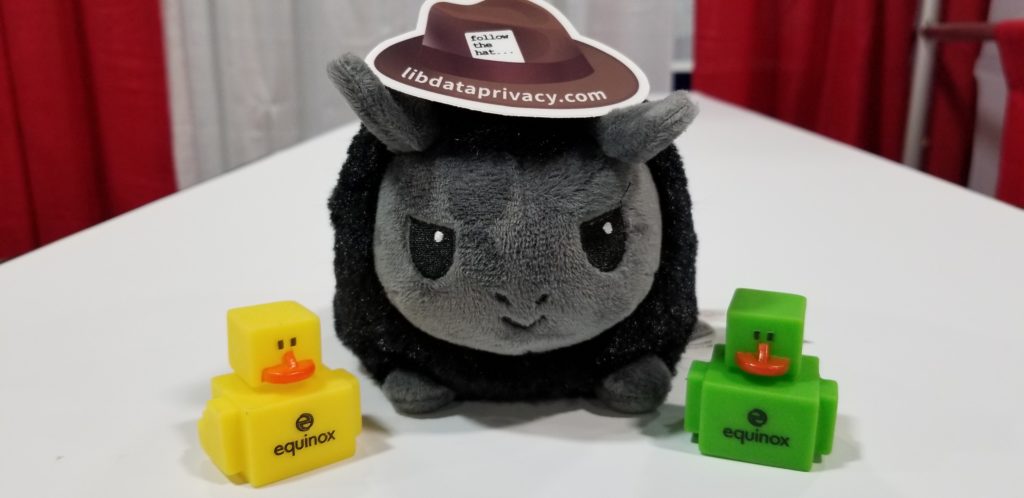It’s been a busy couple of weeks in the privacy world. First, Colorado is poised to be the newest state to join the patchwork of US state data privacy law. Next, Overdrive acquires Kanopy. And then there’s what happened when a patron submits an FOIA request for their data. Privacy forgot that it’s supposed to be summer vacation! Today we’re setting aside those updates and talking about a topic that has been one of the most requested topics for the blog.
You or your colleagues might be scanning through the last couple months of American Libraries in preparation for ALA Annual later this month, only to come across the “Target Acquired” article in the May 2021 issue (page 52-53), profiling three libraries in their use of marketing and data analytic products. The profiles seem harmless enough, from email newsletter management to collection analysis. They want to understand their patrons to serve their communities better. These profiles give three different ways these products can help other libraries do the same.
Did you notice, though, that none of the profiles talked about patron privacy?
There’s a reason for that. Marketing and data analytics products such as customer relationship management systems (CRMS) rely on personal data – the more, the better. The more data you feed into the system, the more accurate the user profile is to create a personalized experience or more effective marketing campaigns. CRMS are increasingly integrated into the ILS – OCLC Wise is an example of such an integration, and other ILS companies plan to release their own versions or create better integrations with existing products on the market. The libraries using Engage and Wise are excited about the possibilities of better understanding their patrons through the data generated by patron use of the library. However, we wonder if these libraries considered the consequences of turning patrons into data points to be managed in a vendor system.
It should be no surprise to our readers that LDH’s approach to marketing and data analytics in libraries does not place data above all else. Data ultimately does not replace the relationship-building work that libraries must do through meeting with community members. However, advertisement pieces such as the one in American Libraries aim to normalize user profiles in CRMS and other analytics products in libraries. As the article states at the beginning, data plays a large part in library outreach. With the pressure to prove their value to the community, library administration and management will reach for data to secure their library’s future in the community. The cost of over-relying on data to prove a library’s value, however, is usually left unexamined in these situations.
With that said, let’s do a little exercise. We have the chance to write a sequel to the advertisement piece. Instead of questions about the products, our questions will turn the tables and focus on the libraries themselves:
What are the privacy risks and potential harms to different patron groups from using the product?
Increased patron surveillance via data collection and user profiling can lead to disproportionate privacy risks for several patron groups. In addition, the business models of several vendors create additional harm by targetting specific minoritized groups, such as reselling data to data brokers or providing data to government agencies such as ICE.
What business need(s) does the product meet? What other products can meet the same need that doesn’t create a user profile or require increased patron surveillance?
Sometimes libraries buy one system that doesn’t match the actual business need for the library. For example, several collection management systems on the market do not require individual-level data to provide analysis as to how to spend collection budgets or meet patron demand. In addition, libraries do not need market segmentation products to perform collection usage analysis.
How does the library reconcile the use of the product with Article III of the ALA Code of Ethics, Article VII of the ALA Library Bill of Rights (and the accompanying Privacy Interpretation document), and other applicable library standards and best practices around patron privacy?
This one is self-explanatory. FYI – “Other libraries are doing the same thing” is not an answer.
What are social, economic, and cultural biases encoded into the product? What biases and assumptions are in the data collection and analysis processes?
Library services and systems are not free from bias, including vendor systems. One bias that some libraries miss is that the data in these systems do not reflect the community but only those who use the library. Even the list of inactive users in the system does not fully reflect the community. Moreover, data alone doesn’t tell you why someone in your community doesn’t have a relationship with the library. Data doesn’t tell you, for example, that some patrons view the library as a governmental agency that will pass along data to other agencies. Data also won’t fix broken relationships, such as libraries violating patron trust or expectations.
What is the library doing to inform patrons about the use of the product? Do patrons fully understand and consent to the library using their data in the product, including pulling data from data brokers and creating profiles of their library use?
More likely than not, your library does not give patrons proper or sufficient notice, nor give patrons the chance to explicitly consent for their data to be collected and used in these products. Refer to the Santa Cruz Civil Grand Jury report on what happens when the public calls out a library using a product in the advertisement article without full patron notification or consent.
Keep these questions in mind the next time you read about marketing and data analytics products in professional magazines such as American Libraries. These advertisement articles are designed to fly under the radar for readers who might not be thinking about the privacy implications of highlighted products and practices. Building relationships with the community require a considerable amount of time and care from the library. Data might seem to be a shortcut in speeding up the process. Nonetheless, choosing to view patrons as targets and metrics can ultimately undermine the foundation of any sustainable relationship.
Reader Survey Open Until June 15th
Thank you to everyone who has filled out the reader survey. If you haven’t filled out the survey yet, we want to hear from you! Take five minutes to help shape the future of the blog by filling out our short survey.












